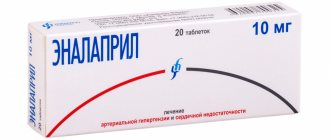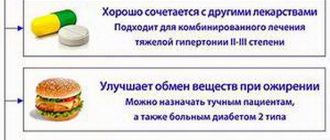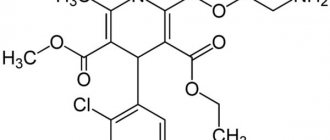Norvasc tablets 5 mg 30 pcs ➤ instructions for use
It can be expected that inhibitors of microsomal oxidation will increase the concentration of amlodipine in plasma, increasing the risk of side effects, and inducers of microsomal liver enzymes will decrease it.
With simultaneous use of Norvasc with cimetidine, the pharmacokinetics of amlodipine does not change.
Unlike other calcium channel blockers, no significant interaction was found with Norvasc® when used in combination with NSAIDs, especially indomethacin.
It is possible to enhance the antianginal and hypotensive effects of calcium channel blockers when used together with thiazide and loop diuretics, verapamil, ACE inhibitors, beta-blockers and nitrates; as well as an increase in their hypotensive effect when used together with alpha1-blockers and antipsychotics.
Although no negative inotropic effect was generally observed in studies of Norvasc®, some calcium channel blockers may enhance the negative inotropic effect of antiarrhythmic drugs that cause QT prolongation (for example, amiodarone and quinidine).
When used together with lithium drugs, calcium channel blockers (no data available for Norvasc) may increase the manifestation of their neurotoxicity (nausea, vomiting, diarrhea, ataxia, tremor, tinnitus).
Amlodipine does not affect the degree of plasma protein binding of digoxin, phenytoin, warfarin and indomethacin in vitro.
A single dose of aluminum/magnesium-containing antacids does not have a significant effect on the pharmacokinetics of amlodipine.
A single dose of sildenafil in a dose of 100 mg in patients with essential hypertension does not affect the pharmacokinetic parameters of amlodipine.
Repeated use of amlodipine at a dose of 10 mg and atorvastatin at a dose of 80 mg is not accompanied by significant changes in the pharmacokinetics of atorvastatin.
When amlodipine was administered concomitantly with digoxin in healthy volunteers, serum levels and renal clearance of digoxin did not change.
With single and repeated use at a dose of 10 mg, amlodipine does not have a significant effect on the pharmacokinetics of ethanol.
Amlodipine does not affect changes in prothrombin time caused by warfarin.
Amlodipine does not cause significant changes in the pharmacokinetics of cyclosporine.
A simultaneous single dose of 240 ml of grapefruit juice and 10 mg of amlodipine orally is not accompanied by a significant change in the pharmacokinetics of amlodipine.
Pharmacological properties
Pharmacodynamics.
amlodipine is a calcium antagonist (dihydropyridine derivative) that blocks the flow of calcium ions to the myocardium and smooth muscle cells. The mechanism of the hypotensive effect of amlodipine is due to a direct relaxing effect on vascular smooth muscle. The exact mechanism of the antianginal effect of amlodipine is not well understood, but the following effects play a role:
1) amlodipine dilates peripheral arterioles and thus reduces peripheral resistance (afterload). Since the heart rate remains stable, the reduction in cardiac workload leads to a decrease in energy consumption and myocardial oxygen demand;
2) dilation of the main coronary arteries and coronary arterioles (normal and ischemic) may also play a role in the mechanism of action of amlodipine. This expansion increases myocardial oxygen saturation in patients with coronary artery spasm (Prinzmetal's angina or variant angina).
In patients with hypertension, use of the drug once a day provides a clinically significant reduction in blood pressure over 24 hours in both lying and standing positions. Due to the slow onset of action of amlodipine, acute hypotension is usually not observed.
In patients with angina pectoris, when using 1 daily dose of the drug, the total time of physical activity, the time before the onset of angina pectoris and the time to 1 mm of ST segment depression increase. The drug reduces the frequency of angina attacks and reduces the need for nitroglycerin.
Amlodipine is not associated with any metabolic side effects or changes in plasma lipid levels and can be used in patients with asthma, diabetes mellitus and gout.
Pharmacokinetics
Suction/distribution. After oral administration of therapeutic doses, amlodipine is gradually absorbed into the blood plasma. The absolute bioavailability of the unchanged molecule is about 64–80%. Cmax in blood plasma is achieved within 6–12 hours after administration. The volume of distribution is about 21 l/kg body weight; The acid dissociation constant (pKa) of amlodipine is 8.6. In vitro studies have demonstrated that the binding of amlodipine to plasma proteins is about 97.5%. Concomitant food intake does not affect the absorption of amlodipine.
Metabolism/excretion. T½ from blood plasma is about 35–50 hours. Equilibrium concentration in blood plasma is achieved after 7–8 days of continuous use of the drug. Amlodipine is mainly metabolized to form inactive metabolites. About 60% of the administered dose is excreted in the urine, about 10% of which is amlodipine unchanged.
Elderly patients. The time to reach equilibrium concentrations of amlodipine in blood plasma is similar in elderly and adult patients. The clearance of amlodipine is usually slightly reduced, which in elderly patients leads to an increase in AUC and T½ of the drug.
Patients with impaired renal function. Amlodipine is extensively biotransformed to inactive metabolites. 10% of amlodipine is excreted unchanged in the urine. Changes in amlodipine plasma concentrations do not correlate with the degree of renal dysfunction. In patients with impaired renal function, normal doses of amlodipine can be used. Amlodipine is not eliminated by dialysis.
Patients with impaired liver function. Information on the use of amlodipine in patients with impaired liver function is very limited. In patients with hepatic impairment, the clearance of amlodipine is reduced, resulting in an increased half-life and an increase in AUC of approximately 40–60%.
Children. Pharmacokinetic studies were conducted in 74 children with hypertension aged 12–17 years (also 34 patients aged 6–12 years and 28 patients aged 13–17 years), who used amlodipine in doses of 1.25–20 mg/day in 1 or 2 doses. Typically, oral clearance in children aged 6–12 and 13–17 years was 22.5 and 27.4 L/h, respectively, for boys and 16.4 and 21.3 L/h, respectively, for girls. There is significant interpatient variability in exposure. Information regarding patients under 6 years of age is limited.
Overdose
Experience with intentional drug overdose is limited.
Symptoms of overdose: Available information suggests that a significant overdose of amlodipine will lead to excessive peripheral vasodilation and possibly reflex tachycardia. Significant and possibly prolonged systemic hypotension, including fatal shock, has been reported.
Treatment: clinically significant arterial hypotension caused by an overdose of amlodipine requires active support of the cardiovascular system, including frequent monitoring of cardiac and respiratory functions, elevation of the limbs, monitoring of blood volume and urination.
To restore vascular tone and blood pressure, you can use vasoconstrictor drugs, making sure that there are no contraindications to their use. IV calcium gluconate may be useful in counteracting the effects of calcium channel blockade.
In some cases, gastric lavage may be helpful. The use of activated charcoal in healthy volunteers for 2 hours after administration of 10 mg of amlodipine significantly reduced its absorption.
Since amlodipine is highly protein bound, the effect of dialysis is negligible.
Side effects
The most commonly reported adverse reactions with amlodipine were drowsiness, dizziness, headache, palpitation, flushing, abdominal pain, nausea, leg swelling, edema and fatigue.
Adverse reactions reported during the use of amlodipine are listed below by system and organ class and by frequency of occurrence: very common (≥1/10), common (≥1/100–1/10), uncommon (≥1/1000 –≤1/100), rare (≥1/10,000–≤1/1000), very rare (≤1/10,000).
From the blood and lymphatic system: very rarely - leukopenia, thrombocytopenia.
From the immune system: very rarely - allergic reactions.
Metabolic and nutritional disorders: very rarely - hyperglycemia.
Mental disorders: uncommon - depression, mood changes (including anxiety), insomnia; rarely - confusion.
From the nervous system: often - drowsiness, dizziness, headache (mainly at the beginning of treatment); infrequently - tremor, dysgeusia, syncope, hypoesthesia, paresthesia; very rarely - hypertonicity, peripheral neuropathy.
From the organ of vision: often - visual impairment (including diplopia).
From the organ of hearing and labyrinth: infrequently - ringing in the ears.
From the side of the heart: often - increased heartbeat; uncommon - arrhythmia (including bradycardia, ventricular tachycardia and atrial fibrillation); very rarely - myocardial infarction.
From the side of blood vessels: often - hot flashes; infrequently - arterial hypotension; very rarely - vasculitis.
Respiratory, thoracic and mediastinal disorders: often - dyspnea; infrequently - cough, rhinitis.
From the digestive system: often - abdominal pain, nausea, dyspepsia, impaired intestinal motility (including diarrhea and constipation); uncommon - vomiting, dry mouth; very rarely - pancreatitis, gastritis, gum hyperplasia.
From the hepatobiliary system: very rarely - hepatitis, jaundice, increased levels of liver enzymes (which was most often associated with cholestasis).
From the skin and subcutaneous tissue: uncommon - alopecia, purpura, discoloration of the skin, increased sweating, itching, rash, exanthema, urticaria; very rarely - angioedema, erythema multiforme, exfoliative dermatitis, Stevens-Johnson syndrome, Quincke's edema, photosensitivity.
From the musculoskeletal and connective tissues: often - swelling of the legs, muscle cramps; infrequently - arthralgia, myalgia, back pain.
From the kidneys and urinary tract: infrequently - urinary disturbances, nocturia, increased frequency of urination.
From the reproductive system and mammary glands: infrequently - impotence, gynecomastia.
General disorders and conditions at the injection site: very often - swelling; often - increased fatigue, asthenia; Uncommon: chest pain, pain, malaise.
Research: uncommon - increase or decrease in body weight.
Isolated cases of extrapyramidal syndrome have been reported.
Children. Amlodipine is well tolerated when used in children. The adverse reaction profile was similar to that observed in adults. In a study of 268 children, the most commonly reported adverse reactions were headache, dizziness, dilation of blood vessels, nosebleeds, abdominal pain, and asthenia.
Most adverse reactions were mild or moderate. Severe adverse reactions (mainly headache) were detected in 7.2% of patients when using 2.5 mg amlodipine, in 4.5% when using 5 mg amlodipine and in 4.6% in the placebo group. The most common reason for exclusion from the study was uncontrolled hypertension. At no time was exclusion from the study caused by laboratory abnormalities. No significant changes in heart rate were recorded.
Reports of suspected adverse reactions. Reporting suspected adverse reactions after drug registration is important. This allows continuous monitoring of the balance between benefits and risks associated with the use of this drug. Physicians should report any suspected adverse reactions as required by law.
special instructions
The safety and effectiveness of amlodipine in hypertensive crisis have not been assessed.
Patients with heart failure. In this category of patients, Norvasc should be used with caution. In a long-term placebo-controlled study in patients with severe heart failure (NYHA class III and IV), amlodipine was associated with a higher incidence of pulmonary edema compared with placebo. In patients with chronic heart failure, calcium channel blockers, including amlodipine, should be used with caution as they may increase the risk of future cardiovascular events and deaths.
Patients with impaired liver function. Amlodipine T½ and AUC are greater in patients with impaired liver function; There are no dosage recommendations. Therefore, in this category of patients, the use of the drug should be started with a minimum dose. Caution should be exercised both when starting to use the drug and when increasing the dose. Patients with severe hepatic impairment may require slow dosage titration and careful monitoring of their condition.
Elderly patients. Increasing the dose of the drug in this category of patients should be done with caution.
Patients with renal failure. In this category of patients, the usual doses of the drug should be used. Changes in plasma concentrations of amlodipine do not correlate with the degree of renal dysfunction. Amlodipine is not eliminated by dialysis.
Amlodipine does not affect the results of laboratory tests.
It is not recommended to use amlodipine with grapefruit or grapefruit juice, since in some patients the bioavailability may be increased, which will lead to an increase in the hypotensive effect of the drug.
Fertility. Reversible biochemical changes in the sperm head have been reported in some patients when using calcium channel blockers. There is insufficient clinical information regarding the potential effect of amlodipine on fertility.
Use during pregnancy and lactation. The safety of amlodipine during pregnancy has not been established. The use of amlodipine during pregnancy is recommended only in cases where there is no safer alternative, and the risk associated with the disease itself outweighs the possible harm from treatment for the mother and fetus. Reproductive toxicity has been observed in animal studies at high doses.
Breastfeeding period. It is not known whether amlodipine passes into breast milk. When deciding whether to continue breastfeeding or to use amlodipine, it is necessary to evaluate the benefits of breastfeeding for the child and the benefits of using the drug for the mother.
The ability to influence reaction speed when driving vehicles or operating machinery. Amlodipine may have a slight or moderate effect on the ability to drive or use machines. Reaction speed may be reduced if symptoms such as dizziness, headache, confusion, or nausea are present. Therefore, caution should be exercised, especially at the beginning of therapy.
Note!
Description of the drug Norvasc table. 5mg No. 30 on this page is a simplified author’s version of the apteka911 website, created on the basis of the instructions for use.
Before purchasing or using the drug, you should consult your doctor and read the manufacturer's original instructions (attached to each package of the drug). Information about the drug is provided for informational purposes only and should not be used as a guide to self-medication. Only a doctor can decide to prescribe the drug, as well as determine the dose and methods of its use.




